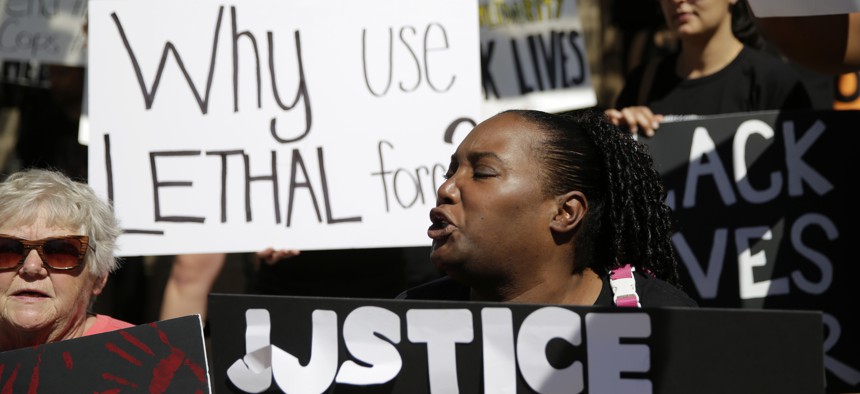One City’s Journey to Filing Complaints About Police Online

Residents of Austin protest police brutality after the shooting of teenager David Joseph by a police officer in 2016. Eric Gay/AP
Austin, Texas, debuted an anonymous online feedback form that eases the process for residents to describe interactions they have with police officers
It used to be very hard to submit a complaint about an interaction with a police officer in Austin. A person would fill out an official form, and attach a notarized affidavit to it. The complainant then would need to file the document, with a valid government ID, at an office located in a police building in North Austin, a part of the city with limited public transportation options.
“Barrier after barrier made it extremely difficult for the community to talk about their experiences with the police,” said Marni Wilhite, the head of product for the Texas city’s Office of Design and Delivery.
Wilhite recently led an initiative to change that. In collaboration with Austin’s Office of Police Oversight, Wilhite’s team built an online, anonymous form for resident feedback about their interactions with the police.
The anonymity is key to making sure the new form is utilized, officials said, although people can provide their personal information and help in any investigation going forward. “The whole process used to be terrifyingly official,” said Ben Guhin, Austin’s head of design and technology policy.
The fight for oversight
The online form grew out of the efforts of activists like Chas Moore, the founder of the Austin Justice Coalition, who began pushing in earnest for a revised police contract with greater civilian oversight after the 2016 police shooting of David Joseph, an unarmed and naked black teenager. The issue of oversight also arose that same year when Breaion King, a black woman, tried to file a complaint about being slammed to the ground multiple times during a traffic stop, only to find that the one-year statute of limitations, set in the police contract, wouldn't allow her to proceed.
In Austin, though black people make up only 8% of the population, they are subject to 25% of traffic stops and are arrested at more than double the rate of white and Latino residents. Police also use force disproportionately against African American residents, as 23% of people shot by police are black. Moore said that these numbers forced the community into action.
.jpg)
For 18 months, the Austin coalition of activists turned their attention to the contract between the city and police union as a way to force greater oversight. They found an ally in Councilmember Greg Casar, who brought the problem about the complaint process to the negotiations. "My hope is that everyone in the community recognizes that some of these changes are not extreme asks and should not require extreme measures to get,” Casar told the Austin Chronicle. "When [they] brought up that there are people who complain to the [Office of the Police Monitor] and then aren't allowed, because of our lack of transparency, to even know what happened to that complaint, it brings into question why we even have that in the first place.”
Negotiations ran into an impasse, and the police contract expired in December of 2017. That meant that the Office of the Police Monitor (the predecessor to the Office of Police Oversight) could not accept complaints through the first nine months of 2018 until a contract was reached. Instead, formal complaints had to go through the department’s Internal Affairs division.
While statistics show that African American residents of Austin have disproportionately more contact with police, Guhin said the old formal process was utilized mostly by white and higher income residents. An Austin Police Department report on racial profiling showed only four formal complaints about profiing and nine informal complaints—those that might be left on a police department’s voicemail—in 2018.
There’s a difference between formal complaints and contacts made to the Office of the Police Oversight, however. A formal complaint is one investigated by Internal Affairs, but a contact is recorded anytime a resident lodges a complaint with the office. Of the 977 contacts recorded in 2018, only 40 resulted in formal investigations. The low formal complaint number is something that further convinced Moore of the necessity of creating more robust civilian oversight and a more convenient complaint option.
“There’s no way a number that low could be true in any city,” said Moore. “Austin would be a utopia if there were only 50 complaints a year.”
When contract negotiations finally settled, the police received $80 million in benefit hikes, in exchange for the public’s ability to easily submit anonymous complaints, the elimination of the notarized affidavit requirement, and the condition that citizens receive follow-ups on their complaints so that they know the results of investigations. The Office of the Police Monitor was also revamped as an independent organization and renamed (becoming the Office of Police Oversight) to make it clear that it was a neutral third party.
The office was put in charge of receiving and reviewing newly anonymized complaints. All that was left was the construction of the online form.
Introducing an Online Option
The Austin Justice Coalition became a part of the working group that reviewed prototypes and provided feedback to Wilhite’s team at the Office of Design and Delivery as they developed the form. Wilhite’s team presented biweekly updates to the working group based on research they conducted with a wide stakeholder group, including community members and police leadership. “We sat together in a room and read real complaints, so we could have an honest conversation about the challenges people in the community face.”
The working group also provided feedback on design, which was fully customizable. “One cool thing about our team structure is that designers and developers are part of the research project together,” said Guhin, who also worked on the design process. “A lot of government designers get hit with, ‘the developer says I can’t do this, so that’s the end of that.’ But we want our goals to direct the technology, not the other way around.”

Wilhite anticipates that the information submitted through this form will make Austin a more data-informed city, where public input is analyzed and used to make iterative improvements to city services. And because they built their form using an open source, modular architecture, the Office of Design and Delivery hopes that other local governments can use the platform for their custom needs.
Ken Casaday, president of the Austin Police Association, said that the form simply represents business as usual for the police department. “We have no problem with the form, because we always allowed anonymous complaints, if someone would call in and leave us a message, for example, we would always investigate that,” said Casaday.
Prior to the form, somebody with a complaint could file with the civilian office, Internal Affairs, or complain to the officer’s supervisor, and while anonymous complaints were allowed, they weren’t well publicized, a 2016 audit found.
“It’s really a trust issue,” Casaday continued. “The activist community didn’t believe we were investigating these complaints before. So they’re excited about the new option.”
Farah Muscadin, director of the Austin Office of Police Oversight, said the form was much needed. “Many people feared retribution if they called or submitted a complaint,” she said.
In the first two weeks since the debut of the new form, the city received 20 complaints and five compliments. Once a complaint gets submitted using the form, which is available in English and Spanish, it is assigned to a complaint specialist from the Office of Police Oversight. During their preliminary review, they look for available police reports or video from police cars or body cameras from the time of the complaint. If they suspect a policy violation might have occurred, the complaint is sent on to Internal Affairs, which handles the investigation moving forward.
But the anonymity cuts both ways. “Anonymous means anonymous to us,” Muscadin emphasized. “If there is no personal information submitted with the form, we can’t follow up.”
If a resident does choose to provide their information, though, they’ll get monthly updates on the status of their complaint, either by phone or by email. Depending on the seriousness of the complaint, the process could take up to six months. The updates for the first few months will show if a sergeant has been assigned to the case, if information gathering has been completed, and if witnesses and the officers involved have been interviewed. Muscadin explained that the final updates will show if the complaint is then under review by the chain of command for potential disciplinary action.
Moore said he hopes that with the new form’s followup structure, complaints will be taken more seriously. “I think the number of complaints that get investigated will drastically increase. That’s why we fought for that so much for that option,” he said.

In addition to the data, Wilhite also believes that the form could improve community relations with police, and noted that submitting compliments through the form would be a good way to do so. “When we talk about behavior change and improving community relations, it’s really important to recognize positive work as well,” Wilhite said.
The Office of Police Oversight is now conducting a tour through local libraries around the city to meet with community members and explain how to use the form to file complaints and compliments.
The Austin Justice Coalition is also advocating for the community to use the form. “It’s great that people can anonymously submit complaints from the comfort of their own homes. But it’s going to take more than people being aware of the form for change to happen. The biggest factor in mistrust between police and the community is lack of accountability,” Moore said. “If regular citizens do something wrong, we get a ticket or go to jail. So we need to see the officers that people are filing complaints about held accountable. That will improve community relations.”
Emma Coleman is the assistant editor for Route Fifty.
NEXT STORY: To Control Forest Fires, Western States Light More of Their Own






